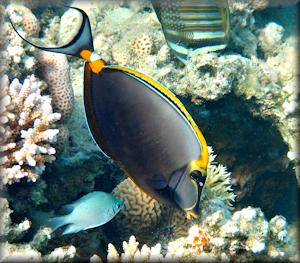How to Snorkel for Underwater Photography
Being aware of currents when snorkeling
if the current is strong you may want to drift snorkel but photography can be difficult - perhaps lie by the pool instead
It all looks so tranquil in the tropics, lots of sun and little tide so, why would you
expect a current?
Currents tend to be quite variable, time of day, state of the tide, prevailing breeze or wind, wind yesterday or even wind and weather in an adjacent area.
They are rarely dangerous but your snorkeling photography can benefit or be hindered by them.
In most resorts there is a dive centre or someone around to ask about currents.
Currents tend to be quite variable, time of day, state of the tide, prevailing breeze or wind, wind yesterday or even wind and weather in an adjacent area.
They are rarely dangerous but your snorkeling photography can benefit or be hindered by them.
In most resorts there is a dive centre or someone around to ask about currents.
Often, it pays to make
your own observations and note what other snorkellers are doing.
When first enter the water just simply float. Watch the bottom and assess the current.
What do you want of the current? I relax when there is little, but ultimately it is currents that lead to great coral and fish.
A small current flowing over you can stabilise you and reduce your tendency to float just as you pause to take a shot..
When first enter the water just simply float. Watch the bottom and assess the current.
What do you want of the current? I relax when there is little, but ultimately it is currents that lead to great coral and fish.
A small current flowing over you can stabilise you and reduce your tendency to float just as you pause to take a shot..


You may decide to 'go with the flow'. Very relaxing as you cover a lot of area for
little effort but may not help if you spot a fish to photograph.
You mightl be moving too fast to position yourself and stop, while you focus and shoot (fins need reverse thrusters!).
Probably you will have to go downstream of the fish, dive and swim back towards it against the current. Works fine if the current isn't too strong.
You mightl be moving too fast to position yourself and stop, while you focus and shoot (fins need reverse thrusters!).
Probably you will have to go downstream of the fish, dive and swim back towards it against the current. Works fine if the current isn't too strong.
If the current is incomfortable, simply get out. It will probably change in a couple
of hours.
If very uncomfortable (rare), the rule is to swim at a right angle to it, towards the land or jetty. Boat anchor lines can be good for a rest
Ditch that weight belt. More buoyancy and swimming is easier. You are more important.
That's why there's a fast release clip on the belt..
If very uncomfortable (rare), the rule is to swim at a right angle to it, towards the land or jetty. Boat anchor lines can be good for a rest
Ditch that weight belt. More buoyancy and swimming is easier. You are more important.
That's why there's a fast release clip on the belt..
The scourge of the surge - a surge underwater from waves will
also most likely wreck your snorkeling photography.
Obviously visibility is likely to be reduced by particles in the water.
Being pushed and pulled back and forth as the waves roll over above you, makes it virtually
impossible to focus on anything, even a large rock or coral, never mind a fish.


